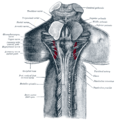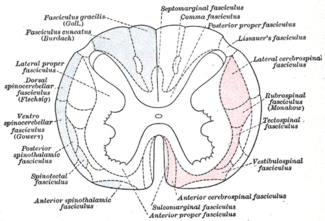Gracile fasciculus
| Gracile fasciculus | |
|---|---|
|
Gracile fasciculus is labeled in blue at upper right. | |
|
Diagram of the principal fasciculi of the spinal cord. | |
| Details | |
| Identifiers | |
| Latin | Fasciculus gracilis medullae spinalis |
| NeuroLex ID | nlx_144039 |
| TA |
A14.1.02.243 A14.1.04.018 |
| FMA | 73938 |
The gracile fasciculus (fasciculus gracilis or tract of Goll) is a bundle of axon fibers in the posterior column-medial lemniscus pathway of the spinal cord and carries information from the middle thoracic and lower limbs of the body. The gracile fasiculus is one of many ascending tracts, which carry received sensory information to the brain via the spinal cord.
Function
The gracile fasciculus provides conscious proprioception of the lower limbs and trunk to the brainstem.
Additional functions of the gracile fasciculus include carrying deep touch, vibrational, and visceral pain information to the brainstem. The gracile fasciculus and the cuneate fasciculus offer the same functions but can be differentiated by the vertebral level at which information is provided. The cuneate fasciculus carries information from vertebral level T6 and above, and the gracile fasciculus carries information from vertebral levels T7 and below. The two ascending tracts meet at the T6 level.
Ascending tracts typically have three levels of neurons that relay information from the physical point of reception to the actual point of interpretation in the brain. The fasciculus gracilis has first-order, second-order, and third-order nerve fibers described below:
First-order fibers: found on the ipsilateral side of the spinal cord; ends at the gracile nucleus in medulla oblongata of the brainstem.
Second-order fibers: found in the medulla; decussate in the medulla as internal arcuate fibers and, together with the second-order fibers of the cuneate fasiculus, create nerve fiber tracts called the medial lemniscus, which relays the information received from the first-order neurons to the thalamus.
Third-order fibers: fibers which relay the signal received from the medial lemniscus at the thalamus to the cerebral cortex.
Clinical significance
Damage to either of these tracts can result in the permanent loss of sensation in the limbs. See Brown-Séquard syndrome.
Additional Information
The gracile fasciculus is wedge-shaped on transverse section and lies next to the posterior median septum, its base being at the surface of the spinal cord, and its apex directed toward the posterior gray commissure. The gracile fasciculus increases in size from anterior to superior.
The tract of Goll, or the common name of the gracile fasciculus, was named after Swiss neuroanatomist Friedrich Goll (1829–1903).
Images
 Decussation of pyramids.
Decussation of pyramids. Superficial dissection of brain-stem. Lateral view.
Superficial dissection of brain-stem. Lateral view. Superior terminations of the posterior fasciculi of the medulla spinalis.
Superior terminations of the posterior fasciculi of the medulla spinalis. The sensory tract. (problem with this picture. Upper limb synapses with nucleus gracilis..)
The sensory tract. (problem with this picture. Upper limb synapses with nucleus gracilis..) Upper part of medulla spinalis and hind- and mid-brains; posterior aspect, exposed in situ.
Upper part of medulla spinalis and hind- and mid-brains; posterior aspect, exposed in situ.- Human caudal brainstem posterior view description
- Fourth ventricle. Posterior view.Deep dissection.
References
Dougherty, Patrick. "(Section 2, Chapter 4, Part 2) Neuroscience Online: An Electronic Textbook for the Neurosciences | Department of Neurobiology and Anatomy – The University of Texas Medical School at Houston." Neuroscience Online: An Electronic Textbook for the Neurosciences | Department of Neurobiology and Anatomy – The University of Texas Medical School at Houston. Web. 30 Nov. 2010. <http://neuroscience.uth.tmc.edu/s2/ii4-2.html>.
Saladin, Kenneth S. Anatomy & Physiology: The Unity of Form and Function. Dubuque: McGraw-Hill, 2010. Print.

